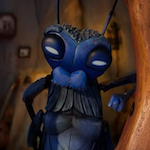 Well, would you look at that? Guillermo del Toro (BLADE II) finally finished his stop motion version of Pinocchio! Looks like it was first announced 15 years ago. Like with his Frankenstein and his In the Mountains of Madness I’d kind of given up on it ever happening. Then when it clearly really was happening it was stop motion so it took some years.
Well, would you look at that? Guillermo del Toro (BLADE II) finally finished his stop motion version of Pinocchio! Looks like it was first announced 15 years ago. Like with his Frankenstein and his In the Mountains of Madness I’d kind of given up on it ever happening. Then when it clearly really was happening it was stop motion so it took some years.
After all that it’s kind of a bummer that it’s a Netflix production with too limited a theatrical release for me to see it on the big screen. But they do seem to be promoting it more than most of their movies, and maybe more people will watch it at home than would’ve if a real movie company put it out. I don’t know. The point is he finally got to make it (co-directing with Mark Gustafson, a Will Vinton claymation veteran and animation director for THE FANTASTIC MR. FOX). And even better, I think it’s really good.
I wasn’t sure I would love it. I was a little put off in the opening, because this Geppetto has a young son named Carlo who is… dare I say, pretty annoying? Something bothered me about this boy (Alfie Tempest) who seems to have no friends, life or interests outside of spending the day with his strangely-old-to-have-a-young-son father. Mrs. Vern said I hated Carlo because he was an obedient little boy, which made me realize why he had to be that way: he’s what Pinocchio will think he has to live up to. But I don’t know, man. Of course it’s incredibly sad for this elderly man to lose his young son and only friend, but it would move me even more if the kid wasn’t so damn cloying.
 No matter. That’s over quick, and it’s a good opening otherwise. Although Geppetto (voice of David Bradley – the one from the HARRY POTTER movies, not the one from the AMERICAN NINJA movies) has a cuckoo clock or two he doesn’t specialize in the fun novelties that the Disney one does – his woodcarving skills are so revered that he’s greeted as “Master Geppetto” as he walks through town. The square-jawed Podesta (Ron Perlman, POLICE ACADEMY: MISSION TO MOSCOW) praises him as “a model Italian citizen.” He brings Carlo with him when he works on the almost-finished crucifix that hangs at the front of the church. But Carlo becomes a casualty in a random act of World War I inhumanity when Austrian bombers dump their payloads to keep from being weighed down, not even specifically targeting the village.
No matter. That’s over quick, and it’s a good opening otherwise. Although Geppetto (voice of David Bradley – the one from the HARRY POTTER movies, not the one from the AMERICAN NINJA movies) has a cuckoo clock or two he doesn’t specialize in the fun novelties that the Disney one does – his woodcarving skills are so revered that he’s greeted as “Master Geppetto” as he walks through town. The square-jawed Podesta (Ron Perlman, POLICE ACADEMY: MISSION TO MOSCOW) praises him as “a model Italian citizen.” He brings Carlo with him when he works on the almost-finished crucifix that hangs at the front of the church. But Carlo becomes a casualty in a random act of World War I inhumanity when Austrian bombers dump their payloads to keep from being weighed down, not even specifically targeting the village.
Geppetto spends years grieving and drinking, as Carlo’s favorite pinecone (long story) grows into a tree right next to his grave. And that’s where our narrator, Sebastian Cricket (Ewan McGregor, ROBOTS) comes in.
I don’t know the book, but I’ve read that the cricket is only in it briefly and then Pinocchio kills him with a hammer, later to be judged again by his ghost. Del Toro’s approach is closer to Walt Disney’s Jiminy Cricket, but I like his spin on it. Sebastian is a traveler who has just settled down in a hole inside the pine tree to write his memoirs when drunken, grieving Geppetto chops it down and carves it into Pinocchio. After Geppetto falls down some stairs and passes out (the puppet’s crude look is due to being unfinished), a Wood Sprite takes pity and brings his puppet to life to comfort him. When Sebastian speaks up for his rights as a homeowner, the Sprite placates him by suggesting he act as Pinocchio’s heart, since he already lives in a hole in his chest. (Flattering him into compliance by telling him he has an important job.)
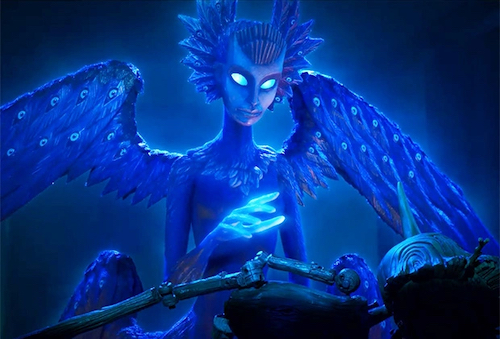 The Wood Sprite is bright blue and has glorious wings covered in eyes, and I was so swept up in the pure del Toro of it all that it didn’t even occur to me for a while that this is his take on The Blue Fairy. Duh.
The Wood Sprite is bright blue and has glorious wings covered in eyes, and I was so swept up in the pure del Toro of it all that it didn’t even occur to me for a while that this is his take on The Blue Fairy. Duh.
The existence of Pinocchio freaks people out – even Geppetto at first. He locks him in a closet to prevent him from going to church, but he goes anyway and scares the shit out of everybody. It’s the same church from years ago, still bomb damaged, and he wonders why everybody seems to like that other wooden guy (Geppetto’s unfinished Jesus) but not him.
As in most versions of the story, Pinocchio is sent to school, but gets abducted to perform in a marionette show. Del Toro (being classy now, I guess) ditches the animal-people, so there’s no fox, but instead the sharp-nosed, giant-haired human Count Volpe (Christophe Waltz, THE GREEN HORNET).
I had no problem separating this in my mind from Disney’s PINOCCHIO, except when Pinocchio comes out on stage and starts to sing, because it can’t help but live in the shadow of “I’ve Got No Strings.” This is also a musical, and the songs (by Alexandre Desplat, FANTASTIC MR. FOX) are fine, but not my favorite part. Maybe it’s worth having them just for the joke that every time Sebastian tries to start up a musical number he gets interrupted. (He finally gets to perform it from beyond the grave during the end credits.)
The movie really gets cooking when Pinocchio falls in the street and gets hit by a car. He finds himself in some sort of afterlife or purgatory, inside a pine coffin with his likeness carved into the lid, carried by black rabbit skeleton pallbearers (Tim Blake Nelson, JOE’S APARTMENT). But Pinocchio gets out of the coffin and interrupts the rabbits’ card game, saying he’s bored.
They send him to talk to Death, who confirms that he’s technically immortal, but when he dies he has to wait for her hourglass to run out before he can return. She’s the Wood Sprite’s sister and is a similar but even cooler design, with eyes on enormous horns, and feline hindquarters but with two tails that stand up like cobras. Both characters are voiced by Tilda Swinton in her second stop motion movie (after ISLE OF DOGS).
After he comes back to life he willingly rejoins Count Volpe’s puppet troupe to get money for supporting his old man… and to avoid the draft! (That’s my del Toro!)
So get this. Count Volpe decides to turn his show into nationalistic propaganda, and manages to get grunty li’l Benito Mussolini (Tom Kenny, the voice of Spongebob Squarepants) to attend a performance. But by this time Pinocchio has grown utterly bored with the material and decides to revamp it to be more about poop and farts. I don’t think he has any understanding of who or what he’s subverting, but I still think he deserves a few antifa points. Mussolini is not a fan, and has Pinocchio shot and the theater burned down. (Whatever happened to freedom of speech?)
Pinocchio comes back to life of course, and Count Volpe survives, to later seek revenge. One thing I like is that Volpe’s monkey assistant Spazzatura (who doesn’t speak, but his grunts and wheezes are provided by Academy Award winner Cate Blanchett, THE GIFT) ends up siding with Pinocchio. It’s a trope I always enjoy, but what makes this extra sweet is that even as a good guy Spazzatura looks like a fuckin asshole. In his first scene I thought he was a gremlin. But he can’t help it, he was born looking like that (and given the Italian word for garbage as his name). He can still learn to be nice. Good for him.
With del Toro’s established appreciation for carnivals, I’d expect him to go hog wild on the Pleasure Island part. To my surprise he has no Pleasure Island (or Toyland, as it’s apparently called in the book). Del Toro’s substitution is Very Serious but I think pretty brilliant – Pinocchio gets sent to a military training camp. Instead of kids being lured in by the freedom to misbehave, they’re being forced to follow commands, and instead of being turned into donkeys to work in salt mines they’re being turned into cannon fodder for a fascist dictator. Same shit, different assholes.
The character called Lampwick in the Disney version retains the original name, Candlewick. Here he’s the Podesta’s son, and he’s voiced by Finn Wolfhard (IT). He takes after his dad and bullies Pinocchio at first, but eventually they become friends and Pinocchio teaches him not to be such spazzatura.
We do get the traditional climax of rescuing Geppetto from the belly of a whale (I guess it’s a giant dogfish), combined with the famous nose-growing-from-lying idea. So the structure we’re familiar with is still there, just reinvented at every other stage.
Looking strictly at the character design, I think Henry Selick’s WENDELL & WILD is a more appealing 2022 stop motion Netflix release. Del Toro based the look on an edition of the book illustrated by Gus Grimley, and I really don’t like those drawings. (I feel like an asshole writing that, but I figure Grimley shouldn’t give a fuck what I think after Guillermo del Toro liked it so much he made a movie out of it!) I’m glad they released concept art in that style years ago, because it made me less anxious for the movie to come out.
In the end, only enormously nosed and haired Lord Volpe (who looks and moves like one of the more annoying Jim Carrey characters) bugs me. Overall it’s a gorgeous movie to look at, as sophisticated in its craft (including the cinematography of Frank Passingham [CHICKEN RUN, KUBO AND THE TWO STRINGS]) as the best modern stop motion productions, if not as stylized, being based in something closer to a natural world. It still has beautiful sights to show you. Look at these buildings:
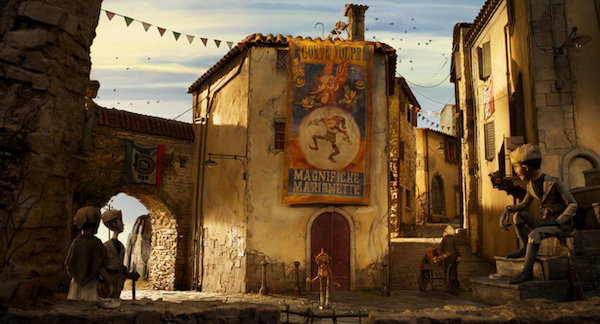
The type of location that would be great if it was real, but becomes astounding when you know somebody sculpted and painted its every detail just for that shot. And I shouldn’t play down how wonderful the more fantastical elements are, especially the blue characters. Look at this guy!
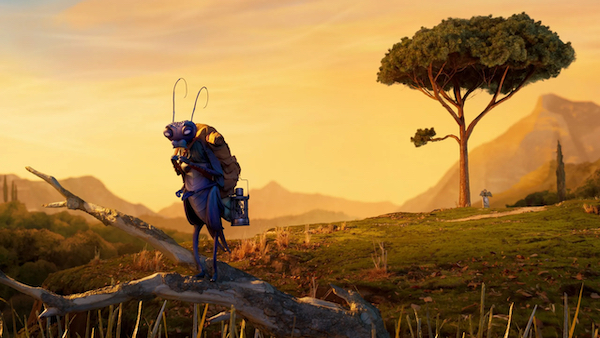
And this gal!
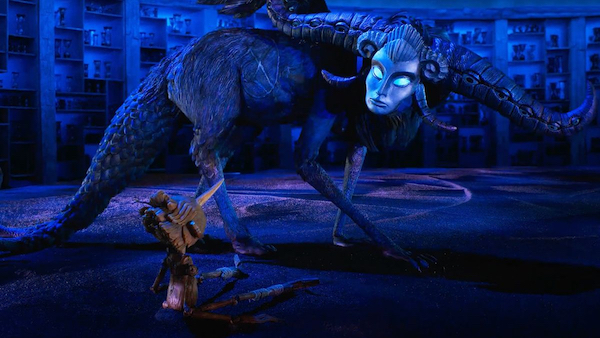
Those are my two favorite characters. The heart and the reaper. Love and death.
And this PINOCCHIO’s greatest feature (very much in contrast to the aforementioned Selick movie) is its script, which is credited as story by del Toro and his long time collaborator Matthew Robbins (director of THE LEGEND OF BILLIE JEAN and BINGO), and script by del Toro and Patrick McHale, an Adventure Time staff writer who created the great 2014 animated mini-series Over the Garden Wall. (I finally caught up with that one this year, and I highly recommend it. Very cute and funny but also kinda creepy, with a very good autumn atmosphere.)
Their adaptation reworks and retells this classic story in a way that seems timeless and traditional, yet completely fresh and del Toro. It is clearly very personal – not so much “I’d like to do a cartoon!” as “I have something I want to say in this medium.” Like THE DEVIL’S BACKBONE and PAN’S LABYRINTH it contrasts the innocence of childhood and fairy tales against the terrors of war and death, but I think this one is actually made to work for kids and adults both. They’ll get different things out of it, but that’s what movies are best at.
(warning to parents: Liam O’Donnell said on Action For Everyone that it made his kids cry, and not in a good way)
I’m thankful that I have this compulsion to write about movies, because the process helps some of the stuff that breezes past me while viewing sink in. While watching it, I found the epilogue (in which, MAJOR SPOILER MAJOR SPOILER MAJOR SPOILER, Pinocchio outlives and mourns Geppetto, Sebastian and even god damn Spazzatura – that’s the one that got me) profoundly moving. Del Toro lost his father several years ago and his mother right before the premiere (and the movie is dedicated to them), and I recognize that feeling of being forced to wrestle with mortality, grief and acceptance. But maybe the sudden UP-montage-level heaviness coming at the very end of the movie threw me off, because it felt like it kind of came out of nowhere.
As I write about it I realize the obvious – that this whole story is about Geppetto being so unable to handle the loss that humanity threw at him that nature itself reached out and created Pinocchio to soothe him. So Pinocchio’s later years represents progress. When it’s his turn to lose everyone that’s important to him he doesn’t become an angry drunk. He learns to keep their memories with him (represented by literally keeping Sebastian’s body in his heart!), appreciate the time he had with them, and continue for however much time he’s been allotted. It’s all you can do, really.
I know we’re not supposed to speak of Robert Zemeckis’s CG remake of PINOCCHIO from earlier this year, but I’m a critic who plays by my own rules, so I’m doing it. I think it’s interesting that Zemeckis and del Toro both added something that’s not from the book or the 1940 Disney masterpiece – that Pinocchio is sort of Geppetto’s replacement for a dead son. In a way that’s closer to A.I.: ARTIFICIAL INTELLIGENCE, Spielberg and Kubrick’s riff on PINOCCHIO. In the Zemeckis version it’s possible to interpret him as a reincarnation, but Geppetto recognizes him as an individual (and at the end as a “real boy” whether or not his wood magically turns to flesh). Del Toro’s conclusion is similar, but even better. Geppetto apologizes for “trying to make you someone you were not” and tells him “Don’t be Carlo. Or anyone else. Be exactly who you are.” The possibility of literally becoming “a real boy” is not a concern in this telling, and the change is so natural I didn’t even think about it.
With those nitpicks I expressed earlier about Carlo and some of the designs, I may sound more negative about this than many of the reviews you’ve seen. But the more I sit with it the more I think it’s truly a great movie, a new animated classic, and definitely somewhere in the top half of del Toro’s filmography. Imagine that – his first animated movie is a retelling of a story we all know from one of the best and most famous animated movies ever made, and yet it truly stands on its own and feels like an entirely different thing. An individual. A real movie. I love it just how it is.


























December 28th, 2022 at 1:58 pm
“I think it’s interesting that Zemeckis and del Toro both added something that’s not from the book or the 1940 Disney masterpiece – that Pinocchio is sort of Geppetto’s replacement for a dead son.”
The cynic in me wonders if they weren’t worried about Geppetto coming off as a pedo for wanting to be a father without a ‘he misses his dead son!’ justification. Which is odd, given I’ve heard of quite a few movies about single women wanting to have kids.